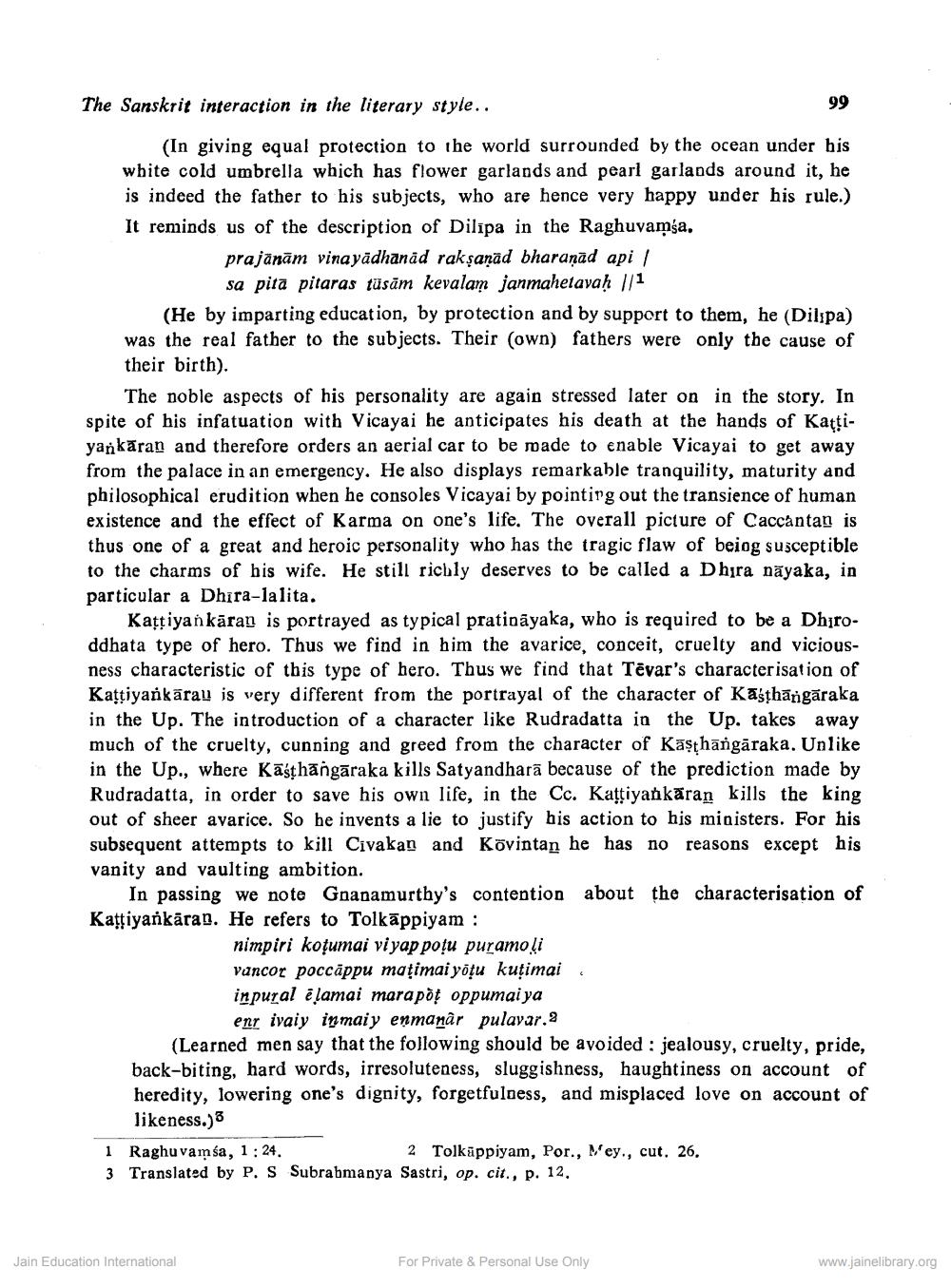________________
The Sanskrit interaction in the literary style..
99
(In giving equal protection to the world surrounded by the ocean under his white cold umbrella which has flower garlands and pearl garlands around it, he is indeed the father to his subjects, who are hence very happy under his rule.) It reminds us of the description of Dilipa in the Raghuvamsa.
prajänām vinayādhanad rakṣanād bharaṇad api /
sa pita pitaras tüsām kevalam janmahetavaḥ 1/1 (He by imparting education, by protection and by support to them, he (Dilspa) was the real father to the subjects. Their (own) fathers were only the cause of their birth).
The noble aspects of his personality are again stressed later on in the story. In spite of his infatuation with Vicayai he anticipates his death at the hands of Kattiyankāran and therefore orders an aerial car to be made to enable Vicayai to get away from the palace in an emergency. He also displays remarkable tranquility, maturity and philosophical erudition when he consoles Vicayai by pointirg out the transience of human existence and the effect of Karma on one's life. The overall picture of Caccantan is thus one of a great and heroic personality who has the tragic flaw of beiog susceptible to the charms of his wife. He still richly deserves to be called a Dhira nāyaka, in particular a Dhira-lalita.
Kațțiyankāran is portrayed as typical pratināyaka, who is required to be a Dhiroddhata type of hero. Thus we find in him the avarice, conceit, cruelty and viciousness characteristic of this type of hero. Thus we find that Tēvar's characterisation of Kattiyankārau is very different from the portrayal of the character of Kāšțhāngāraka in the Up. The introduction of a character like Rudradatta in the Up, takes away much of the cruelty, cunning and greed from the character of Kāşthāngāraka. Unlike in the Up., where Kāšķhāngāraka kills Satyandharā because of the prediction made by Rudradatta, in order to save his own life, in the Cc. Kattiyankāran kills the king out of sheer avarice. So he invents a lie to justify his action to his ministers. For his subsequent attempts to kill Civakan and Kõvintan he has no reasons except his vanity and vaulting ambition.
In passing we note Gnanamurthy's contention about the characterisation of Kattiyankäran. He refers to Tolkāppiyam :
nimpiri koțumai viyap poțu puramoli vancor poccāppu mațimai yoțu kuțimai, inpural ēlamai marapoț oppumai ya
enr ivaiy inmaiy enmanâr pulavar.2 (Learned men say that the following should be avoided : jealousy, cruelty, pride, back-biting, hard words, irresoluteness, sluggishness, haughtiness on account of heredity, lowering one's dignity, forgetfulness, and misplaced love on account of
likeness.)3 1 Raghuvamsa, 1:24.
2 Tolkāppiyam, Por., Mey., cut, 26. 3 Translated by P. S Subrabmanya Sastri, op. cit., p. 12.
Jain Education International
For Private & Personal Use Only
www.jainelibrary.org




